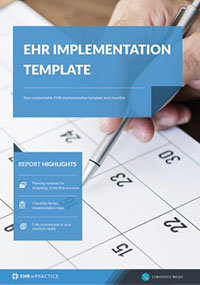10 EHR failure statistics: why you need to get it right first time
Organizations within healthcare and in other industries who are tasked with carrying out large scale technology projects are often reminded of cautionary tales of massive failures. These failures, which in the context of EHR projects, often garner attention in the press given they are often accompanied by a catastrophic event related to massive financial losses or a widespread system failure that results in services being compromised. These types of failures are not common, the more common situations that could be considered an EHR implementation failure are less dramatic. In these cases, the consequences of the failure are not dramatic and to the outside observer wouldn’t be noticed.
When considering the topic of EHR failures it is important to understand that what can be described as a “failure” encompasses a wide variety of situations. It’s easy to simply think of an EHR implementation failure as those rare and extreme cases in which the EHR, after being implemented, is unable to be used without significant disruption to a practice’s operations or results in a significant negative financial impact on an organization. These are examples of EHR implementation failures but are rare cases. Rather than focus on extreme and rare cases, it is important to note that EHR failures occur in many shapes and forms. What can be classified as a failure depends on the context and should be viewed through the lens of its impact on an organization.
Defining EHR implementation failure
EHR failure can be defined as an inability to perform its required function, or subjectively as a failure to live up to expectations. The definition of failure is subjective and is contingent on the expectations attached to a project. Success, or inversely failure, is tied to meeting objective milestones such as on-time and on-budget delivery or a project’s ability to further an organization’s goals. In sum, the definition of failure is contextual and will vary from each organization. As such one can envision cases where an organization’s failure would be considered a successful implementation, depending on expectations.
Find the right EHR first time round with this step-by-step EHR selection survival guide
How often does EHR failure occur?
Across all industries, estimates indicate that 25 percent of technology projects fail outright. 20 to 25 percent don’t show any return on investment, and up to 50 percent of technology projects will require massive reworking after being launched. Among EHR projects, estimates reveal similar failure rates. According to the Fox Group, a health care consulting firm, 20% of EHR system installations could be considered a failure.
Other estimates of EHR failure, indicate a much higher failure rate. More than 50% of EHR systems either fail or fail to be properly utilized. Research published in the journal Procedia Computer Science, shows health care technology projects fail at a rate of up to 70% of the time when failure is defined as when a project results in an unintended negative consequence, such as a “project delay, a substantial cost overrun, a failure to meet an intended goal, or complete abandonment of the project.”
Ten EHR failure statistics
As discussed previously, EHR failures can take on many forms and involve a broad scope of areas, and often involve failures in multiple areas. The following statistics touch on topical areas that are commonly cited in the context of EHR failures.
1. Patient safety risk
When an EHR compromises patient safety, dire consequences can result. Quantros, a private health care analytics firm, states that in the period between 2007 and 2018 it has logged 18,000 EHR-related patient safety events. Of these events, 3 percent resulted in patient harm, including seven deaths. Further, a 2016 study by The Leapfrog Group, a patient-safety watchdog group discovered that the medication-ordering functionality of hospital EHRs failed to flag potentially harmful drug orders in 39 percent of cases in a test simulation, 13 percent of those cases, the mistake could have been fatal.
2. High clinician burnout
Clinician burnout is a serious concern from a human resources and quality of clinical care perspective. A poorly planned workflow or incompatible system interface can cause clinicians to suffer from burnout. A study published recently indicates that clinical process design and the clinical culture, both of which can be negatively impacted by an EHR, contribute to approximately 40% of total clinician stress. A study conducted by Stanford University indicates that EHR-related burnout rates may be much higher. In the study, 74 percent of respondents reported that the total number of hours they work each day has increased since the EHR was implemented and 71 percent reported that their EHR contributed to what they consider to be burnout.
Avoid EHR failure by using our free EHR implementation template
3. EHR as a contributor to low job satisfaction
Job satisfaction among clinicians is an important component of a successful organization. If an EHR is contributing to dissatisfaction on the job, an organization may need to examine its EHR strategy. In a recent survey conducted by Stanford University, 54 percent of those surveyed showed that their EHR detracted from professional satisfaction.
4. Declines in clinical effectiveness
Just as professional satisfaction is important if clinical staff believe an EHR is hindering their ability to perform their job an organization may need to examine whether its EHR implementation has gone according to plan. In the Stanford survey referenced previously, 49 percent of clinicians surveyed indicated that their EHR reduced their clinical effectiveness.
5. EHR-related financial problems
Many practices experience implementation failure based on their failure to model costs that can arise during implementation and afterward. Given the data available on implementations, a sizable majority of practices showed that financial problems plagued their implementation. Survey data from the MPI Group and Medical Economics indicate 65% of respondents who recently implemented new EHR software say their EHR systems resulted in financial losses for the practice. About 43% of internists and other specialists/subspecialists outside of primary care characterized the losses as significant.
6. Poor usability
In a recent study published in Mayo Clinic Proceedings, the question of EHR usability was examined. In a large-scale survey of US physicians, one-quarter of the respondents also rated their EHR’s usability on a standard technology usability measure known as the System Usability Scale (SUS). The scale assigns a letter grade to usability with highly usable systems receiving an A and an unusable system receiving an F. The study noted that users in other studies ranked Google’s search engine with an “A” for usability. Microwave ovens, ATMs and Amazon’s website received “Bs.” Microsoft Word, DVRs and GPS platforms received “Cs.” EHRs were among the worst rated in usability receiving an F.
7. Productivity and efficiency loss
Productivity and efficiency drops can be expected during implementation. However, if these declines last beyond the implementation period they can be considered symptoms of an EHR failure. For example, a survey conducted by American EHR Partners and the American Medical Association found more than half of the survey's respondents reported their EHR was the cause of a negative impact in their practice with regard to cost, productivity, and efficiency.
8. Patient engagement failure
One of the primary areas of focus among policymakers crafting standards for EHR use involved engaging patients more actively in their care through patient portals whereby they could communicate with providers and access their own records. Despite efforts to encourage health care organizations to implement patient portals, patients still overwhelmingly do not use them. A study analyzing patient portal use among insured patients found 63 percent of survey participants reported not using a patient portal during the past year, and 60 percent reported not having been offered access to a portal.
9. Patient dissatisfaction
When an EHR is not implemented properly the negative impact is not only felt by those working on the inside. Rather, when a health care organization do not use their EHR in a meaningful way, patient satisfaction can decline. According to a survey conducted by Black Book, 89 percent of patients under the age of 40 stated that they are currently dissatisfied with their organizations’ use of patient engagement technology. Black Book Research’s managing partner Doug Brown said "healthcare consumers more frequently interact through electronic media in 2018, and while they value contact with their providers, they don't have the patience for lacks in hospital interoperability, incorrect billing and access to scheduling and results."
Another 84 percent of patients said they are specifically looking for providers who use advanced health IT that helps patients communicate with their doctors and engage with their own health data.
10. Financial risk for hospitals
According to credit rating firm Moody’s, hospitals that roll out a new EHR put themselves at a significant risk of financial losses through incurring operating losses, lower patient volumes and receivables write-offs. Although this is not the case for all hospital EHR roll outs, these large organizations are at a higher risk of these financial losses due to their scale.
The statistics presented above provide both context and an illustration of the causes and symptoms of EHR failure. These statistics offer a way to examine the cause of failure and ways to mitigate the risk of a failure occurring.
Free white paper

EHR Implementation Template
Get all the planning tools you need to make your EHR implementation a success

Featured white papers
Related articles
-

Avoid EHR implementation failure by doing these three things
Three top tips to avoiding EHR disaster during implementation
-

Small practice EHR implementation mistakes to avoid
The most common mistakes made by small practices during EHR implementation
-

3 common EHR implementation pitfalls and how to avoid them
Exclusive guest blog from MicroMD discussing the most popular challenges faced during EHR impleme...




